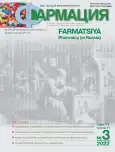Изучение микродиагностических признаков облепихи крушиновидной листьев
- Авторы: Ковалёва Н.А.1, Тринеева О.В.1, Гудкова А.А.1, Колотнева А.И.1, Носова Д.К.1
-
Учреждения:
- ФГБОУ ВО «Воронежский государственный университет»
- Выпуск: Том 71, № 3 (2022)
- Страницы: 18-23
- Раздел: Статьи
- URL: https://journals.eco-vector.com/0367-3014/article/view/113703
- DOI: https://doi.org/10.29296/25419218-2022-03-03
- ID: 113703
Цитировать
Полный текст
Аннотация
Введение. Для разработки новых растительных лекарственных препаратов требуется постоянное расширение сырьевой базы как новыми нефармакопейными лекарственными растениями, так и нетрадиционными морфологическими группами сырья уже хорошо изученных видов. Внедрение в медицинскую практику такого лекарственного растительного сырья (ЛРС) требует его стандартизации для возможности получения и реализации лекарственных растительных средств на его основе и, следовательно, обусловливает необходимость разработки нормативной документации. Цель исследования. Изучить микродиагностические признаки облепихи крушиновидной листьев для формирования раздела «Микроскопия» в проекте фармакопейной статьи на данных вид ЛРС. Материал и методы. Объект исследования - высушенные листья облепихи крушиновидной (Hippophae rhamnoides L.), заготовленные на территории Воронежской области (Острогожский район) в период технической зрелости плодов. Заготовка и сушка листьев осуществлялась в соответствии с общей фармакопейной статьей «Листья». Пробоподготовка сырья осуществлялась с применением различных методик. Микроскопия проводилась согласно общей фармакопейной статье «Техника микроскопического и микрохимического исследования лекарственного растительного сырья и лекарственных растительных препаратов» Государственной фармакопеи Российской Федерации XIV издания методом световой микроскопии на микроскопе Биомед 6 (Россия) с применением видеокамеры Livenhuk C310 NG (КНР) и программным обеспечением Top View (х86). Результаты. Выявлены основные микродиагностические признаки цельных листьев облепихи крушиновидной (сетчатое жилкование; 3 вида волосков: щитковидные, звездчатые и щитковидно-звездчатые; аномоцитный тип устьичного аппарата (на нижней стороне листа); многоугольные с верхней и с сильноизвилистыми стенками с нижней стороны листа клетки эпидермиса). Определены также биометрические характеристики основных микродиагностических признаков. Заключение. Выбраны оптимальные методики проведения микроскопического исследования листьев облепихи крушиновидной, с помощью которых установлены анатомо-диагностические признаки облепихи крушиновидной листьев высушенных цельных.
Полный текст
Об авторах
Наталья Александровна Ковалёва
ФГБОУ ВО «Воронежский государственный университет»
Автор, ответственный за переписку.
Email: natali-sewer@yandex.ru
аспирант, преподаватель кафедры фармацевтической химии и фармацевтической технологии
Ольга Валерьевна Тринеева
ФГБОУ ВО «Воронежский государственный университет»
Email: trineevaov@mail.ru
доктор фармацевтических наук, доцент, доцент кафедры фармацевтической химии и фармацевтической технологии
Алевтина Алексеевна Гудкова
ФГБОУ ВО «Воронежский государственный университет»
Email: al.f84@mail.ru
доктор фармацевтических наук, доцент, доцент кафедры фармацевтической химии и фармацевтической технологии
Анастасия Игоревна Колотнева
ФГБОУ ВО «Воронежский государственный университет»
Email: nastya.kolotneva.48@gmail.com
студентка IV курса фармацевтического факультета
Диана Константиновна Носова
ФГБОУ ВО «Воронежский государственный университет»
Email: diya.31@mail.ru
студентка IV курса фармацевтического факультета
Список литературы
- Михеев А.М., Деменко В.И. Облепиха. М.: Росагропромиздат, 1990; 48. ISBN 5-260-02610-1
- Справочник Vidal «Лекарственные препараты в России» [Электронное издание]. Режим доступа: https://www.vidal.ru/
- Павлова А.Б., Чиркина Т.Ф. Способ использования древесной зелени облепихи в пищевой промышленности. Современные наукоемкие технологии. 2005; 5: 57-8.
- Имашева Н.М., Елина В.В., Садомцева О.С. и др. Составление БАД на основе растительного сырья. Международный академический вестник. 2014; 3 (3): 52-5.
- Абдыкаликова К.А., Нечипоренко Л.П. Фитохимический состав надземной части облепихи крушиновидной. Вестник КГПИ. 2008; 4: 104-7.
- Айтуарова А.Ш., Жусупова Г.Е. Выделение биологически активных веществ из надземной части растения вида Hippophae rhamnoides L. и возможности их использования в медицине. Вестник Казахского национального медицинского университета. 2016; 3: 195-7.
- Мельников О.М., Верещагин А.Л., Кошелев Ю.А. Исследование биологически активных соединений почек и листьев мужских растений облепихи крушиновидной. Химия растительного сырья. 2010; 2: 113-6.
- Pop, Raluca Maria et al. Carotenoid composition of berries and leaves from six Romanian sea buckthorn (Hippophae rhamnoides L.) varieties. Food chemistry vol. 2014; 147: 1-9. D0l:10.1016/j.foodchem.2013.09.083
- Павлова А.Б., Чиркина Т.Ф., Золотарева А.М. Биологически активная пищевая добавка на основе древесной зелени облепихи. Химия растительного сырья. 2001; 4: 73-6.
- Ибрагимов З.Р., Гайтова Т.Р. Листья облепихи как источник БАВ. Актуальные проблемы химии, биологии и биотехнологии: материалы X всероссийской научной конференции: Северо-Осетинский государственный университет им. К.Л. Хетагурова. 2016; 323-5.
- Чиркина Т.Ф., Золотарева А.М., Пластинина З.А. Перспективные растительные источники биологически активных веществ в Байкальском регионе. Техника и технология пищевых производств. 2009; 1 (12): 71-4.
- Черняк Д.М., Титова М.С. Содержание каротина и витаминов Е и С в дальневосточных растениях. ТМЖ. 2015; 2 (60): 92-3.
- Насудари А.А., Багиров И.М. Исследование облепихи, произрастающей и культивируемой в Азербайджане для получения лекарственных препаратов. Тезисы доклада научной конференции, посвященной 100-летию со дня рождения акад. М. Топчибашева. Баку, 1995; 416.
- Тринеева, О.В., Сливкин А.И. Самылина И.А. Исследования по разработке проектов фармакопейных статей на плоды и масло облепихи крушиновидной. Вестник Воронежского государственного университета. Серия: Химия. Биология. Фармация. 2016; 3: 126-33.
- Государственная фармакопея Российской Федерации XIV изд. [Электронное издание]. Режим доступа: https://femb.ru/femb/
- Attrey, Dharam Paul et al. Pharmacognostical Characterization & Preliminary Phytochemical Investigation of Sea buckthorn (Hippophae rhamnoides L.) Leaves. Indo Global J. of Pharmaceutical Sciences. 2012; 2 (2): 108-13.
- Самылина И.А., Аносова О.Г. Фармакогнозия. Атлас: учебное пособие: в 3-х томах. М: ГЭОТАР-Медиа, 2010; 1: 188. ISBN 978-5-9704-1576-4.
- Потанина О.Г., Самылина И.А. Фармакопейные требования к микроскопическому анализу лекарственного растительного сырья. Фармация. 2015; 4: 47.
Дополнительные файлы













